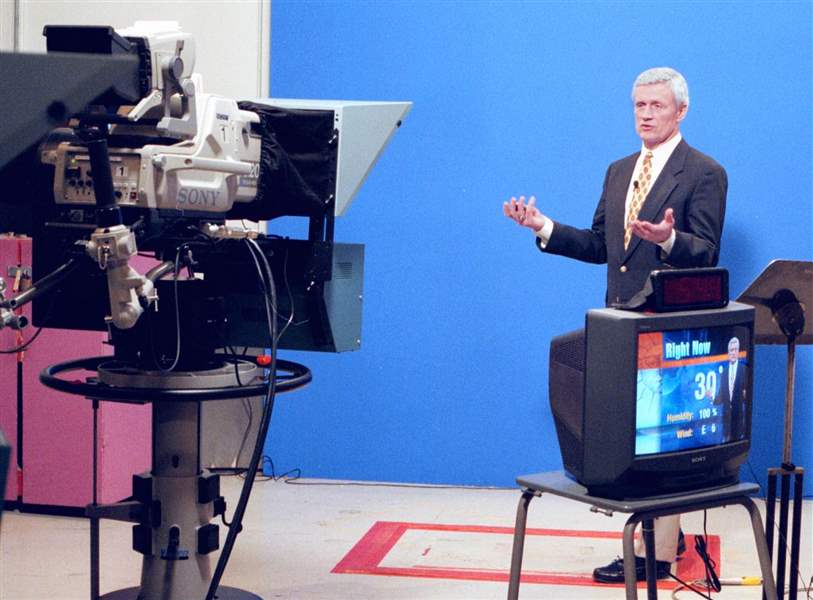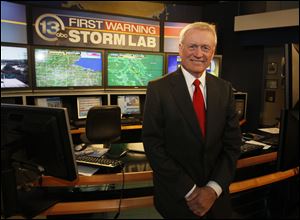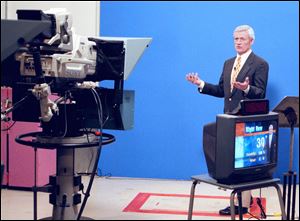
Forecast is sunny for Stachak
Stachak wraps up long career as TV weatherman
4/22/2012
Stan Stachak presents the 5 p.m. forecast in 1997.
THE BLADE
Buy This Image

Stan Stachak is retiring after 30 years of forecasting the Toledo area's weather for WTVG-TV, Channel 13.
Stan Stachak's first audition for a TV weatherman position is memorable for two reasons.
One, he landed the part-time job at a Colorado Springs, Colo., station, thus beginning a nearly 35-year career as a meteorologist.
Two, he was hired despite botching the audition.
RELATED STORY:
"Don't quit your day job," Stachak recalled being told by the station's news director-anchor, who took a chance on him anyway. He later learned the station offered him the job out of desperation rather than management's faith in his on-air improvement.
"When they hired me it was a Thursday and they needed somebody to start Monday and they didn't have anybody. I was in the right place at the right time," Stachak said.
And that's how a local TV fixture got his rather humble start as a weather expert known and respected for his steady, calm presence on air even as Mother Nature does its best to rattle the rest of us. June 1 will mark the 32nd anniversary of Stachak's standing invitation into the living rooms of WTVG-TV, Channel 13, viewers. But his retirement will fall one day short of that mark. The unassuming meteorologist is stepping aside on Thursday, May 31, after quitting all but the 5:30 p.m. broadcasts.
"It's a business of youth. I was a fresh face at one time," said the 63-year-old, "but I think it's time for a Jay Berschback to shine. I've had my time."
Berschback, 38, was recently announced as the station's new chief meteorologist and Stachak's on-air heir.
"Stan's shoes are obviously humongous, but I think he has set the path for us. He has established the groundwork to continue on without him," Berschback said.
Born in Toledo and raised in Temperance, Stachak left the area in the late 1960s with a childhood dream, and it had little to do with weather. He wanted to fly. He enrolled at the U.S. Air Force Academy, but just before graduating he was grounded by a flight surgeon who said he wasn't qualified. Stachak had headaches, which the flight surgeon said could prove dangerous in the sky. It wasn't until a few years later, in 1976, that Stachak found a neurologist who said the headaches weren't the disabling kind, thus granting him permission by the Air Force to fly.
By then Stachak was married and a father to a young girl, and had already turned to a new career: weather forecasting, earning a meteorological degree at the University of Utah and becoming a weather officer for the Air Force.
He left the military by 1977 to find employment as a weatherman, while teaching math and science at a Catholic school in Colorado Springs. That's how he landed his first weather gig. He improved at delivering the nightly weather reports, and soon there were offers nationwide as affiliates in bigger markets looked to be the first in the area to have a meteorologist; this was in stark contrast to the era of the rip-and-read weather presenters and bubbly-blonde weather bunnies usually delivering local forecasts.
Stachak was in a minority of trained meteorologists with TV experience -- who could not only predict the weather, but understand it as well -- which made him a prized commodity.

Stan Stachak presents the 5 p.m. forecast in 1997.
He was handed job offers from stations in Baltimore, Louisville, Indianapolis, and Milwaukee, but turned them all down. Stachak wanted to stay near the Rocky Mountains, and he was holding out for a vacancy in Denver, Phoenix, or Salt Lake City. Finally, he and his wife considered moving back to northwest Ohio/southeast Michigan to be close to their families. Stachak sent resumes to Detroit and Toledo and WTVG responded. The ABC affiliate wanted to hire a meteorologist to compete with news rival WTOL-TV, Channel 11, which had recently hired a meteorologist.
Stachak accepted the offer, which would pay $32,000 -- more than double the $13,000 he was making in Colorado Springs. WTVG even ran a promotional campaign for its new hire, touting Stachak as a military man and local boy returning home. This marked a new direction for Channel 13.
"I don't think weather had been a big part of their operation. Since Channel 11 had hired a meteorologist, it started to up the ante a little bit and weather became competitive," he said. "Of course, we didn't have graphics back then, but we made some real swell-looking magnet maps. They redesigned the set and put some deep gauges in there and I think we called it the Weather Center. I introduced some new technology like the satellite picture."
For a better grasp of the longevity of Stachak's career, compare the early days of Channel 13's weather center to the centerpiece of the station's weather forecasting, a million-dollar Live Doppler Radar. Then consider that shortly after Stachak started at WTVG, Jerry Anderson joined the station as an entry-level reporter and worked with him for 13 years, before moving to WTOL. Anderson is Channel 11's evening co-anchor.
"It was nothing short of a pleasure working with that guy," Anderson said. "He has a high degree of professionalism. He was not some stuffed shirt. He took his job seriously, but in the next breath would double you up with something very funny. Not slapstick, but dry and wry humor.
"I'm not sure people get that on TV and not sure he wants people to get that."
Stachak's informative and no-fuss style of delivery ran counter to the wacky weatherman persona popular through the 1970s and even into the 1980s. (See Anchorman: The Legend of Ron Burgundy.)
"There are all kinds of different ways to give the weather," Berschback said. "You can be professional, you can be fun, you can be serious, you can be loud. The way he does it is the right way, with his Air Force background, speaking almost as a trained scientist -- which we are -- giving the weather as it is, as it happens."
That's not an act, either.
"I guess it's just how I am," Stachak said. "I go by three things: Where it's at, where it's going, and when's it going to get there? So if I concentrate on that then I can keep my cool.
"You've got to stay under control. If people see you panicked ... " he said, his sentence trailing off into that wry grin of which Anderson spoke.
When asked about his most memorable moments at Channel 13, Stachak recalled hosting the station's Wednesday's Child segments in the early 1990s, helping local orphans find adoptive parents. It was personal for Stachak, who, along with wife Maryellen -- who died of ovarian cancer in 2000 -- adopted a boy and girl in 1987 and 1991, respectively.
A few weeks ago, when WTVG announced his retirement, Stachak received an email from a family who adopted a child featured on Wednesday's Child. Despite the impact it had in the community, the segment was canceled a few years after it began by a station consultant looking to change things at WTVG. WTOL picked up Wednesday's Child and continues to air it as Home For Keeps, which airs at least monthly during the 5 p.m. Tuesday newscast.
Despite what the consultant thought about Wednesday's Child, Stachak said it was always popular with viewers.
"It got to the point when I was out in public, people would ask me more about, 'Hey, did that kid with the disability ever get adopted?' than they would ask about the weather."
That consultants aren't always right is one of many on-the-job lessons Stachak has picked up during his more than three decades at WTVG.
Another is not to interrupt a detective show just as the villain is being revealed to deliver a less-than-urgent weather notice. Equally important is never instructing viewers to stay off the roads -- no matter the weather conditions.
"Advertisers don't like that," he said. "Instead, say 'The roads are really bad.' Discourage them but stop short of saying 'Don't drive.' "
While at Channel 13 Stachak had the opportunity to work some vacation release shifts at CNN, meet celebrity guest forecasters Willard Scott and Carol Channing, among others, and once had to deliver the weather from memory, when the monitors he uses to see the graphics in the station failed to be delivered to the remote broadcast.
Surely he's going to miss all this.
"I don't know," he said, "ask me in a couple months, I guess."
Actually, Stachak has a lot to look forward to in his retirement. He plans to reconnect with some of the recreational activities of his youth: small game hunting, fishing, downhill skiing. He has three children from his first marriage -- Allison, 38, Andrew, 24, Sarah, 21 -- and 10 grandchildren. And he's most especially looking forward to spending more time with his wife Mary -- his grade-school sweetheart, whom he married in 2001 -- and less time thinking about the weather.
"I know one thing: The first big snow I'm going to sit there next to my beautiful wife and I'm gonna watch that snow fall and go, 'You know, I wonder how much it's going to snow?' Then shrug my shoulders and go watch TV."
Contact Kirk Baird atkbaird@theblade.comor 419-724-6734.